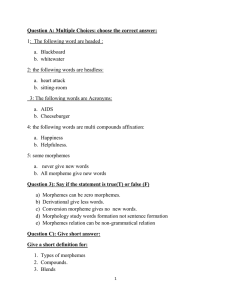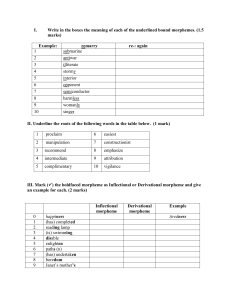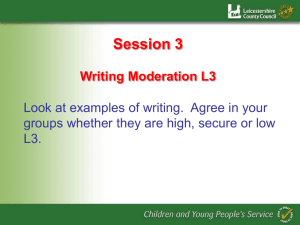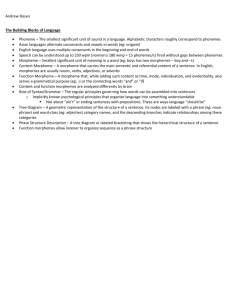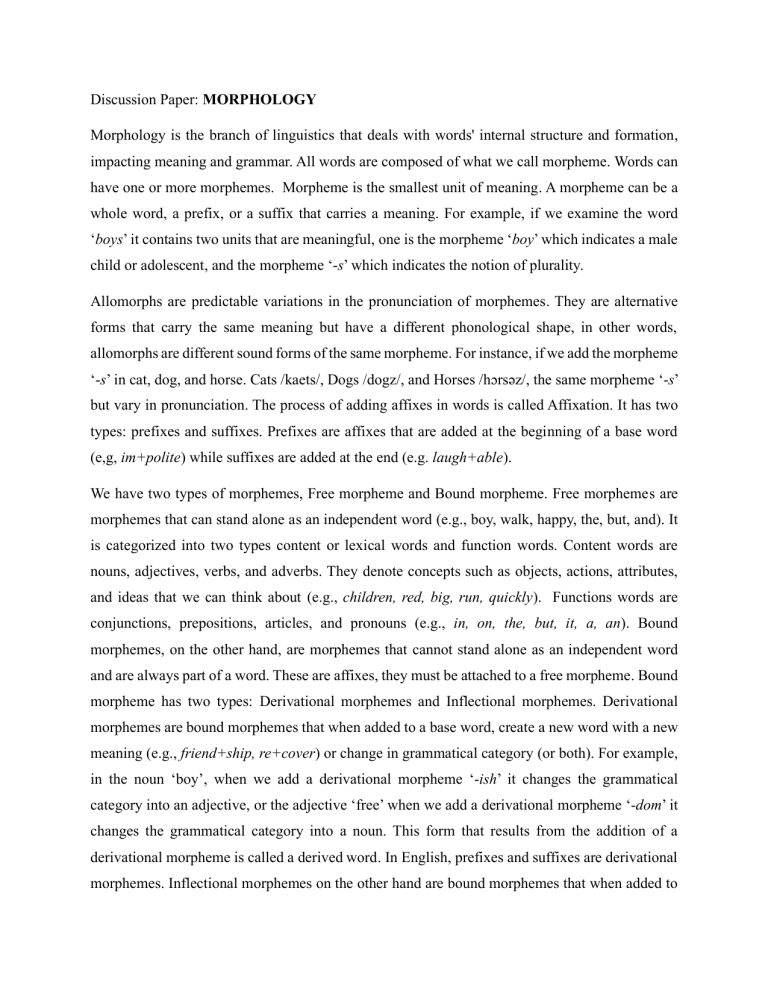
Discussion Paper: MORPHOLOGY Morphology is the branch of linguistics that deals with words' internal structure and formation, impacting meaning and grammar. All words are composed of what we call morpheme. Words can have one or more morphemes. Morpheme is the smallest unit of meaning. A morpheme can be a whole word, a prefix, or a suffix that carries a meaning. For example, if we examine the word ‘boys’ it contains two units that are meaningful, one is the morpheme ‘boy’ which indicates a male child or adolescent, and the morpheme ‘-s’ which indicates the notion of plurality. Allomorphs are predictable variations in the pronunciation of morphemes. They are alternative forms that carry the same meaning but have a different phonological shape, in other words, allomorphs are different sound forms of the same morpheme. For instance, if we add the morpheme ‘-s’ in cat, dog, and horse. Cats /kaets/, Dogs /dogz/, and Horses /hɔrsəz/, the same morpheme ‘-s’ but vary in pronunciation. The process of adding affixes in words is called Affixation. It has two types: prefixes and suffixes. Prefixes are affixes that are added at the beginning of a base word (e,g, im+polite) while suffixes are added at the end (e.g. laugh+able). We have two types of morphemes, Free morpheme and Bound morpheme. Free morphemes are morphemes that can stand alone as an independent word (e.g., boy, walk, happy, the, but, and). It is categorized into two types content or lexical words and function words. Content words are nouns, adjectives, verbs, and adverbs. They denote concepts such as objects, actions, attributes, and ideas that we can think about (e.g., children, red, big, run, quickly). Functions words are conjunctions, prepositions, articles, and pronouns (e.g., in, on, the, but, it, a, an). Bound morphemes, on the other hand, are morphemes that cannot stand alone as an independent word and are always part of a word. These are affixes, they must be attached to a free morpheme. Bound morpheme has two types: Derivational morphemes and Inflectional morphemes. Derivational morphemes are bound morphemes that when added to a base word, create a new word with a new meaning (e.g., friend+ship, re+cover) or change in grammatical category (or both). For example, in the noun ‘boy’, when we add a derivational morpheme ‘-ish’ it changes the grammatical category into an adjective, or the adjective ‘free’ when we add a derivational morpheme ‘-dom’ it changes the grammatical category into a noun. This form that results from the addition of a derivational morpheme is called a derived word. In English, prefixes and suffixes are derivational morphemes. Inflectional morphemes on the other hand are bound morphemes that when added to a base, create a new word of the same word with small or no change in essential meaning or change in grammatical category (e.g., walk, walk-s, walk-ed, walk-ing). Inflectional morphemes are only suffixes. There are 8 inflectional morphemes: 3rd person singular present ‘-s’, past tense ‘-ed’, progressive ‘-ing’, past participle ‘-en’, plural ‘-s’, possessive ‘’s’, comparative ‘-er’, and superlative ‘-est’. We have different word formation processes which explains how new words are formed. Derivation involves the addition of a derivational affix, changing the syntactic category of the item to which it is attached (e.g., discern(v) – discernment(n)). Back formation which forms a word by removing what is mistaken for an affix (e.g., edit from editor). Root creation which is a brand-new word based on no pre-existing morphemes (e.g., coca-cola). Abbreviations and Acronyms are both formed using the first letter(s) of a series of words. They differ in pronunciation (e.g., TV, AIDS). Clipping is the cutting of the beginning or the end of a word or both leaving a part to stand for the whole (e.g., exam for examination, plane for airplane). Compounding involves creating a new word by combining two or more free morphemes (e.g., girl+friend, long+term). Blending results from part of two words being combined to create a single word (e.g., breakfast + lunck = brunch). Category extension is a process in which a word of one grammatical form becomes a word of another grammatical form without any reduction (e.g., eye(noun), eyed (verb)). Folk etymology is a process of forming a word by substituting a common native form for an exotic (e.g., ‘salary from salarium’). Proper names are words formed based on the name of a person or a place (e.g., volt (from the Italian, Alessandro Volta). There are also processes that produce a great deal of linguistic variability, these are called Morphophonemic processes. Assimilation is the process by which a speech sound becomes similar or identical to a neighboring sound (e.g. ‘handbag’/hænd‘bæg/ to ‘hambag’ /hæm‘bæg’/). Dissimilation is a process that results in two sounds becoming less alike in articulatory or acoustic terms (e.g., ‘libary’ instead of ‘library’; ‘govner’ for ‘governor’). Epenthesis is when we add extra sounds within words to make them easier to say and flow more smoothly. It is a process in which a vowel sound, usually a schwa, is inserted either to the end or between two consonant sounds for easier pronunciation (e.g., “film” - we add the schwa sound /ə/ between the /l/ and /m/ sounds). Metathesis is a linguistic phenomenon where the order of sounds or letter gets mixed up accidentally or switched by mistake but are not considered wrong. It occurs in speaking languages, it leads to changing pronunciation but can affect also the spelling of words. (e.g., “ask” becoming “aks”).



